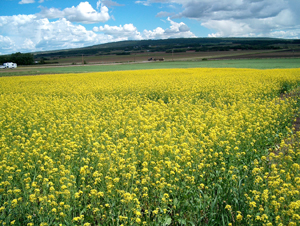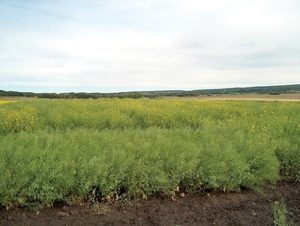
Features
Agronomy
Plant Breeding
Raising the bar for Polish canola
Polish canola tends to be pushed
out of the spotlight by higher yielding Argentine varieties. But Polish
canola does have a place in crop rotations for prairie growers, and
this is especially true with the improved varieties
November 7, 2008 By Carolyn King
New Polish varieties coming up for registration in 2009 are much higher yielding.
 |
 |
| Polish canola offers advantages of early maturity, shatter resistance and drought tolerance in comparison to Argentine. Photos courtesy of Kevin Falk, Agriculture and Agri-Food Canada. |
Polish canola tends to be pushed out of the spotlight by higher yielding Argentine varieties. But Polish canola does have a place in crop rotations for prairie growers, and this is especially true with the improved varieties soon coming out of Agriculture and Agri-Food Canada’s ongoing Polish canola breeding program.
“Seed yield is the most important aspect of our breeding program. We achieve that through developing new synthetics, and we’re also working to develop hybrids in Polish canola. Coupled with that is disease resistance, primarily brown girdling root rot and blackleg, and we keep an eye on white rust or staghead,” says Dr. Kevin Falk, who leads the program.
Falk has been involved in Polish canola Brassica rapa breeding for many years, first with the private sector and then with Agriculture and Agri-Food Canada (AAFC) since 1992. He pioneered the development of synthetic Polish varieties. The AAFC breeding program is run from the Beaverlodge Research Farm near Grande Prairie in northern Alberta. The promising cultivars are tested across the Peace River Region in Alberta and British Columbia, and at one or two sites in the short-season areas of Saskatchewan.
Falk explains that Polish canola offers three key advantages over Argentine Brassica napus. First, Polish canola matures about 10 to 14 days earlier. He adds, “Any stress changes the days to maturity for both the Argentine and the Polish. The Polish tends to hurry up when it’s stressed, and the Argentine sits there waiting for the stress to be relieved. So I’m not a believer in the early napus varieties because if you get any heat or drought stress then you’ve lost your advantage. The only time they work is if everything else works in the environment. The early napus may be a day or two earlier but certainly nowhere close to the two weeks that we see with the Polish.”
The second advantage is that Polish canola is more shatter resistant so it is a better choice for straight cutting. Straight cutting means one less pass over the field, which saves time, money and equipment wear in comparison to swathing.
Third, Polish canola has superior drought tolerance, a valuable trait in the last few years in the Peace Region. Falk says, “According to our work, Polish canola is second only to the mustards, which are very drought tolerant.”
However, as growers know, Polish canola has two disadvantages: it is lower yielding than the Argentine hybrids and many of the open-pollinated Argentines, and there are no herbicide-tolerant Polish varieties.
Thanks to the breeding program, the yield disadvantage will soon be noticeably smaller. Falk says at least five new varieties with substantially improved yields are in the Co-op testing system right now, and several of these will come up for registration in 2009.
Although the program has released several Polish varieties in the past, only two are currently commercial: AC Sunbeam and ACS-C7. The difficulty in getting growers to pick up the program’s varieties caused Falk to take a different tack a few years ago. “We decided to wait until we saw a big jump in yield to narrow the gap between Polish and Argentine before releasing any more varieties. We’ve now raised the bar about 15 percent over where we were before.”
Falk is hoping to tackle the herbicide tolerance issue soon. “We are currently trying to get BASF to allow us to develop Clearfield in Polish canola. So far BASF has resisted, saying the acreage is too small. But I would argue that the acreage would increase if producers were given that option because they want herbicide tolerance. And a Clearfield Polish canola shouldn’t be an issue for the Europeans because it’s not transgenic; it was developed using traditional breeding techniques.”
The Alberta Canola Producers Commission (ACPC) in particular, and the Saskatchewan Canola Development Commission, have been strong funding supporters of the breeding program. The B.C. Grain Producers Association has also contributed in past years. “The big companies don’t have any interest in Polish canola because of the lower yield and the difficulty in hybridization, but the Canola Commission feels that there are some genetics in Polish canola that are worthwhile following up and keeping in the system,” says Clarence Assenheimer, an ACPC director and chair of its Agronomic Research Committee.
Assenheimer outlines the value he sees in having Polish canola available as an option. “For instance,in 2007, it was such a late spring that any of the Polish canola that was left was put into the ground because of the late start. So there is a fit in particular years and for areas with a short growing season. There is also a fit in some of the other parts of the province where they grow winter wheat and want to get the canola off early enough to put wheat in.”
In short-season areas, growing both types of canola can be a good strategy, says Falk. “I think there is a place for both because it spreads out the risk and improves the bottom line. While nothing is for sure, you’re pretty much guaranteed a harvestable crop when you grow Polish.”